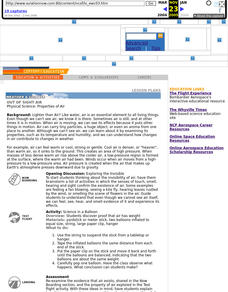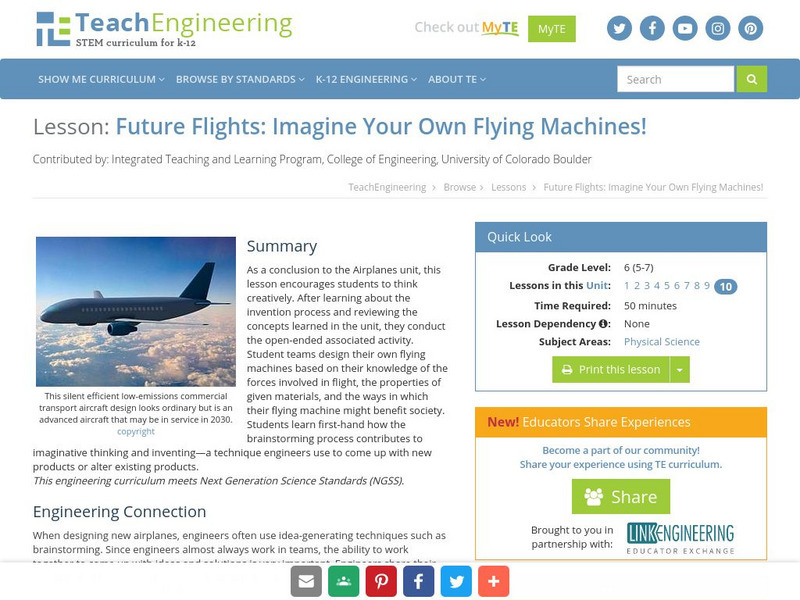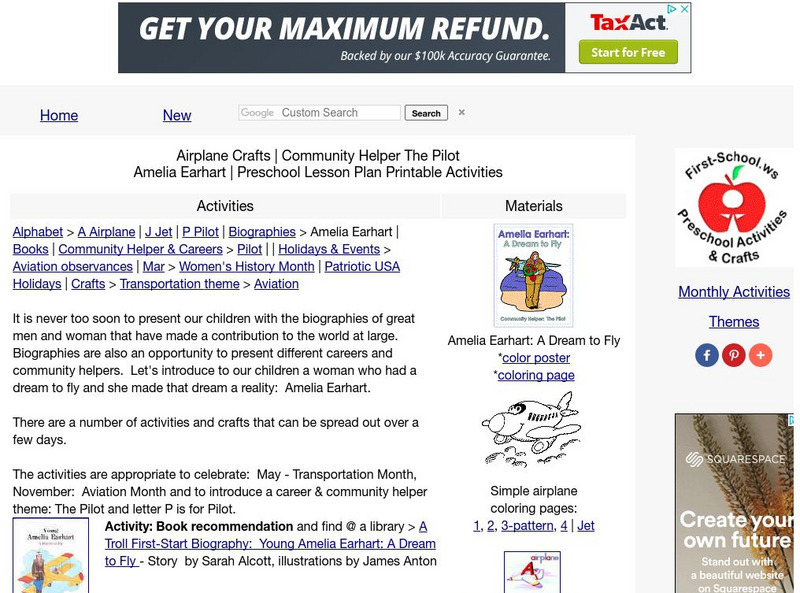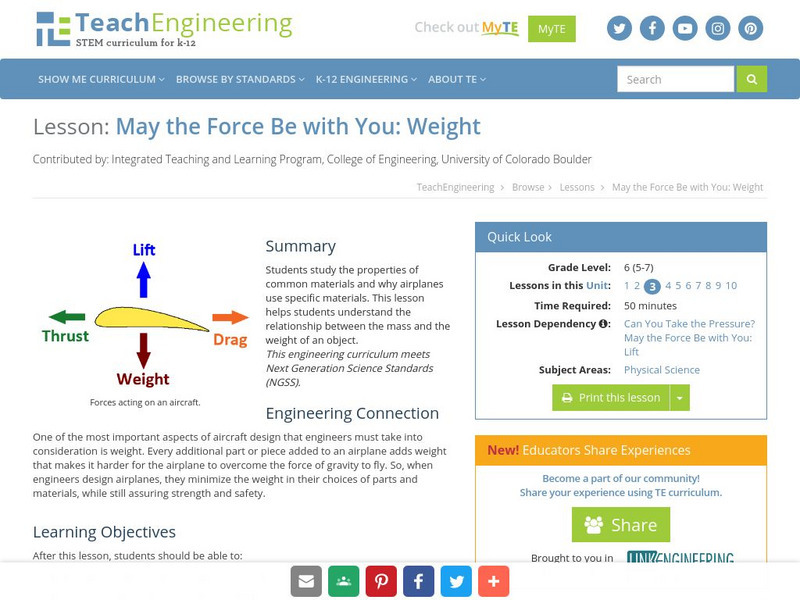Curated OER
The X-33 and the X-38
Students explore the relationships among the lengths, areas, and volumes of similar solids. They also discover what effect doubling the dimensions of a figure has on the resulting area.
Curated OER
Out Of Sight Air; Weather
Fourth graders conduct an experiment to get them thinking about the invisibility of air, and to prove that air has weight.
Curated OER
Perpetual Motion
Students discuss movement of air currents and then experiment to create visible models of air currents. Students connect the model to weather patterns.
Curated OER
The Reason for the Seasons; Science, Geography
Students think about what causes the seasons to change, reflect on what they know about seasons and how their lives affected by seasonal changes.
Curated OER
IS MASS THE SAME AS WEIGHT?
Students see the difference between weight and mass when they examine the method of measuring each of them.
Curated OER
WHAT HOLDS US TO EARTH?
Middle schoolers they imagine they are Galileo and try to duplicate Galileo's experiments and results.
Curated OER
PROBLEMS/SOLUTIONS
Students choose an interesting problem related to space travel and then design a plan to solve the problem. They present their solution to the class.
Curated OER
A DISAPPEARING ACT Astronomy: Do Stars Always Shine?
Students observe why stars are not visible during the day with a classroom demonstration using an index card punched with holes.
Curated OER
Stargazing Astronomy: A Ceiling Full of Stars
Students make an observe a planetarium using a can with nail holes, black paper and a flashlight.
Curated OER
Geometry: Mountain Rescue Mission
Fifth graders improve their skills using map coordinates by playing a mountain rescue game. In pairs, they roll dice to determine their moves up a mountain. The team that reaches the rescue site in the shortest distance on the grid...
Smithsonian Institution
Smithsonian Learning Lab: Airplanes and Airports: How to Take Off Without Ever Leaving the Ground
Smithsonian Education presents "Airplanes and Airports: How to Take Off Without Ever Leaving the Ground." Teachers can download this teaching package that discusses airplanes and airports. Included in the discussion are the forces of...
TeachEngineering
Teach Engineering: Future Flights!
This lesson is an exciting conclusion to the airplanes unit that encourages young scholars to think creatively. After a review of the concepts learned, students will design their own flying machine based on their knowledge of the forces...
University Corporation for Atmospheric Research
Ucar: Learn to Fly! Uav First Flight
Students begin to learn basics of flying UAVs/drones. This simple initial flight includes a take-off, hovering at different heights, and landing.
Smithsonian Institution
Smithsonian Learning Lab: How Things Fly: Activities for Teaching Flight
Through this series of three lessons, students will gain an understanding of the basics of flight. They will learn about the four forces of flight and practice their observation skills through a number of fun experiments. In addition,...
Science Education Resource Center at Carleton College
Serc: Investigating Flight With Paper Airplanes
Students will experiment with different styles of paper airplanes, create questions to test, and design experiments that will allow them to gather data related to their question. They will record their data, using graphs where...
Science Education Resource Center at Carleton College
Serc: Designing Fast and Slow Airplanes and Measuring Velocity
In this activity, young scholars design their own airplanes and fly them. The challenge is to create a fast plane and a slow plane and compare the speed to the design.
TeachEngineering
Teach Engineering: What Makes Airplanes Fly?
Learners begin to explore the idea of a force. To further their understanding of drag, gravity and weight, they conduct activities that model the behavior of parachutes and helicopters. An associated literacy activity engages the class...
Other
Lesson Plan Activities: Amelia Earhart and Airplanes
This site features several activity ideas and activities on Amelia Earhart and airplanes for young learners.
Science and Mathematics Initiative for Learning Enhancement (SMILE)
Smile: Lab Activity: Aviation
This site from the Illinois Institute of Technology provides a student lab activity in which the flight of a paper airplane is investigated and studied. Designed for primary grades, but easily adaptable for junior high students.
PBS
Pbs Teachers: Scientific American: Flying Free: Winging It
Explore flight and the science behind lift and wing shape by creating two paper airplanes - a monoplane glider and a ring-wing glider.
Smithsonian Institution
Smithsonian Learning Lab: Stories of the Wrights' Flights
This lesson plan has students read primary materials from the Smithsonian collection written by the Wright brothers, and compare and contrast them to secondary sources, such as newspaper stories from the next day. There is background...
TeachEngineering
Teach Engineering: May the Force Be With You: Weight
The purpose of this lesson is to help students understand the relationship between the mass and the weight of an object. Students will study the properties of common materials and why airplanes use specific materials.
Alabama Learning Exchange
Alex: Let's Calculate Flight!
Young scholars will use stop watches to help understand elapsed time when they fly paper airplanes through the air. Students will then move on to using clocks. Young scholars will work out elapsed time word problems using made up flight...
PBS
Pbs Learning Media: Higher and Faster
For this interactive lesson, students will explore the social factors, economic factors and engineering innovations that drive higher and faster commercial flights.
Other popular searches
- Flight, Aviation
- Flight Aviation
- Flight, Aviation Powerpoint
- Flight Aviation Powerpoint
- Flight, Aviation Activities
- Flight Aviation Activities
- Aviation Flight Trainging





















